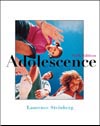 |  Adolescence, 6/e Laurence Steinberg,
Temple University
Psychosocial Development During Adolescence Psychosocial Problems in Adolescence
Learning Objectives1.Understand the four general principles about problems in adolescence. |
 |  |  | 2.Understand the distinction between internalizing disorders and externalizing disorders, and be able to provide examples of each. |
 |  |  | 3.Understand the various perspectives on "problem behavior syndrome," including theories by Richard Jessor, Denise Kandel, and the social control theory. |
 |  |  | 4.Understand the prevalence of adolescent drug and alcohol use, as well as the causes and consequences of such behavior. |
 |  |  | 5.Understand the various approaches to drug and alcohol prevention and treatment programs, and factors that impact their effectiveness. |
 |  |  | 6.Understand the prevalence of antisocial behavior during adolescence as well as the causes of such behavior. |
 |  |  | 7.Understand the approaches to preventing and treating antisocial and violent behavior. |
 |  |  | 8.Understand the nature, prevalence and diagnosis of depression |
 |  |  | 9.Understand the prevalence and causes of suicide among adolescents, and be aware of the risk factors associated with suicide attempts. |
 |  |  | 10.Understand the diathesis-stress model of depression, and treatment for adolescent depression. |
 |  |  | 11.Understand the causes, consequences, and means of coping with stress during adolescence. |
|



 2002 McGraw-Hill Higher Education
2002 McGraw-Hill Higher Education